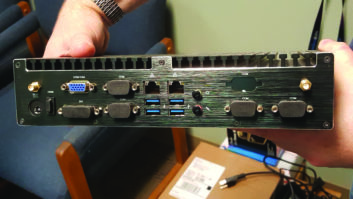
It’s only fair, as we highlighted the lowly tape cartridge label in the last column, that we consider its replacement — the computerized playout system. Starting with large, noisy computers with fans and humming power supplies, engineers were quick to adopt KVM systems (Keyboard-Video-Mouse) extenders. Although cable-rich, they permitted engineers to locate the noisy computer in a server or rack room, thereby extending their control.

As the evolution of systems continues, a new device is in favor — the compact fanless computer. Pictured in Fig. 1, these compact computers are super quiet.
Rick Copeland, technology infrastructure manager at Capital Public Radio in Sacramento, has standardized on the MITXPC, which is now available for a few hundred dollars.
You might think something this inexpensive and compact would be short on features. That is not the case.
The MITXPC has dual Network Interface Cards, plus 2K of RAM. It also will handle a high-definition multimedia interface (aka HDMI) monitor.

Because of the size and price, these compact computers can easily be located in each studio. This frees up valuable rack and cooling space in the server or rack room, though they are slightly warm to the touch, Rick says he hasn’t noticed any studio cooling problems after relocating the compact computers to his studio rooms.
Because only two network Ethernet cables are required, the huge bundle of KVM cabling goes away (see Fig. 3), another plus.
As your computers need to be replaced, consider these cost-effective and efficient replacements when you budget for 2020.
***
Since we are putting everything on computers these days, it’s important to keep an eye on power supply.
I spoke to an engineer recently who was experiencing intermittent clicks on his audio. He traced the problem to bad switching power supply capacitors.
If you don’t have a large stock of extra supplies, at least stock up on spare electrolytics.
Keep in mind that the capacitor temperature has a direct bearing on its lifespan, and that is why it’s important to ensure proper cooling. Defective fans, or dusty supplies raise the electrolytic temperature, hastening failure.
I’ve always heard that under normal conditions, electrolytics had a life expectancy of about 60,000 hours, or nearly seven years. Of course, they can last longer, but keep in mind you may be on borrowed time after you pass the seven-year point.
***
It’s been fun reminiscing with readers about the cart machine label photo in our last two issues; in the process, I learned something new: Several engineers said they used white adhesive bandage tape, rather than the file folder labels, which were difficult to remove.
One engineer said he cut a strip and stuck it on the roller of the typewriter and typed out the cart label. Others used the same kind of tape, but identified the tape contents using a Sharpie-type indelible marker and a highlighter to give some color to the labels.
Also, Clarke Broadcasting’s Paul Shinn explained the difference between the file folder labels and “official” cart labels (which cost more). The “official” labels were a bit wider and shorter, so they fit perfectly on the back of the Fidelipak cartridge.
Phillip Davis pointed out that he worked at a station where each jock had their own color label. This prevented the same voice from being heard back-to-back in a stop set. For music on carts, the color could stand for daypart. Phillip remembers a lot of information being typed on the music carts — in addition to title and artist, tempo, intro time, total time, as well as whether the song faded or ended cold.
During his years in radio, Paul not only worked small, medium and major markets, but did a stint at AFVN in Saigon, Vietnam, in 1970.
It’s fun to reminisce, isn’t it? Thank you all for your memories and comments!
***
As for the winner of the “identify the label” contest, the prize goes to 23-year-old James Copeland.
James writes that he not only knew what the labels were really for, but at 23, he had both recorded and played a cart on the air! James also reminded me that the colored file folder “cart” labels were also used to identify analog audio console inputs! Good call, James. How far we have come.
James writes that he was the PD and later operations manager at student-run KSDB(FM) in Manhattan, Kan., on the campus of Kansas State University.

Twice a year, the station participates in a College Radio Days Vinylthon event. James wanted to make it a totally analog experience, so he found an ITC triple-banger in the closet and some Jones connectors, wired them up and was in business. The only other piece of the puzzle was hooking an Audi-Cord for recording purposes.
All said and done, James wanted the distinction of being the youngest person to install and use a cart system. The experience gave him a new appreciation for how everything used to be, being born 40 years too late.
If you’re yearning for the good old days, James now DJs on resurrected carrier current station 640 WLHA, which existed on the campus of the University of Wisconsin Madison. In addition to 24/7 music, the site has archived air checks from the ’60s and ’70s. Its website is www.lakeshore64.com.
***
Contribute to Workbench. You’ll help fellow engineers and qualify for SBE recertification credit. Send Workbench tips and high-resolution photos to johnpbisset@gmail.com.
Author John Bisset has spent 50 years in the broadcasting industry and is still learning. He handles western U.S. Radio Sales for the Telos Alliance. He is SBE certified and is a past recipient of the SBE’s Educator of the Year Award.







